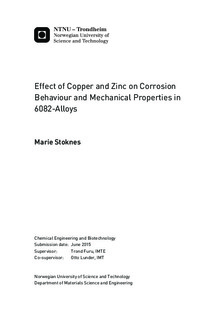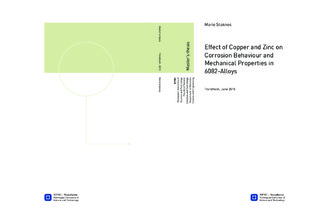| dc.description.abstract | Extruded Al-Mg-Si alloys with Cu additions are frequently used in heavy loaded structures, offshore installations and the transportation industry. In contrast to the positive effect Cu has on mechanical properties, the resistance toward intergranular corrosion is found to descend by the introduction of potential differences in grain boundary regions. This type of corrosion is hard to spot on the material surface, is associated with increased risk for material failure and reduced ductility. Addition of Zn is believed to reduce the Cu-enhanced IGC susceptibility by making grain boundaries less cathodic. An accelerated IGC test was carried out on Cu-containing 6082-profiles with three levels of Zn, differed by rate of cooling after extrusion and ageing condition. The test was followed by optical light microscope examination of cross sectional areas with the aim of evaluating IGC resistance. Effects of adding Cu up to 0.3 wt% and Zn up to 0.6 wt% with variations in cooling rate and ageing time were also studied for mechanical properties and microstructure appearance by obtaining hardness measurements, electrical conductivity measurements and examination in optical light microscope. Furthermore, an Alstruc homogenisation model was applied for simulating the effect of increasing Cu content on precipitation behaviour during solidification and homogenisation.
Results from the IGC test revealed increased IGC frequency and weight loss due to corrosion with raised Zn content. IGC was also slightly promoted by overageing. Microstructure examination showed high influence of cooling rate on depth of recrystallised layers and Cu promoting recrystallisation in centre regions. Moreover, hardness and electrical conductivity were affected by all variables present in this study. Hardness was positively affected by Cu, water quenching and artificially ageing to T6 condition whilst air cooling and ageing raised electrical conductivity. Alstruc simulation indicated a dissolution of the Cu-containing Q-phase associated with IGC during homogenisation which gives reason to expect an absence of Q-phases after extrusion for 6082-profiles examined in this study. | |

